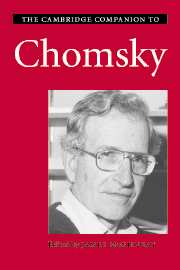Book contents
- Frontmatter
- Introduction
- Part I Chomsky on the human language
- 1 Chomsky’s science of language
- 2 Plato’s Problem, UG, and the language organ
- 3 Grammar, levels, and biology
- 4 How the brain begets language
- 5 Chomsky and Halle’s revolution in phonology
- 6 Universal aspects of word learning
- Part II Chomsky on the human mind
- Part III Chomsky on values and politics
- Notes
- References
- Index
4 - How the brain begets language
from Part I - Chomsky on the human language
Published online by Cambridge University Press: 28 May 2007
- Frontmatter
- Introduction
- Part I Chomsky on the human language
- 1 Chomsky’s science of language
- 2 Plato’s Problem, UG, and the language organ
- 3 Grammar, levels, and biology
- 4 How the brain begets language
- 5 Chomsky and Halle’s revolution in phonology
- 6 Universal aspects of word learning
- Part II Chomsky on the human mind
- Part III Chomsky on values and politics
- Notes
- References
- Index
Summary
I first met Noam Chomsky through a project that attempted to get the baby chimp Nim Chimpsky to “talk.” At nineteen, with the certainty of youth, I knew that I would soon be “talking to the animals.” Nim was the focus of our Columbia University research team’s Grand Experiment: could we teach human language to other animals through environmental input alone with direct instruction and reinforcement principles? Or would there prove to be aspects of human language that resisted instruction, suggesting that language is a cognitive capacity that is uniquely human and likely under biological control? Nim was affectionately named “Chimpsky” because we were testing some of Chomsky’s nativist views. To do so, we used natural sign language. Chimps cannot literally speak and cannot learn spoken language. But chimps have hands, arms, and faces and thus can, in principle, learn the silent language of Deaf people.
By the early 1970s, a surprising number of researchers had turned to learning about human language through the study of non-human apes. Noam Chomsky had stated the challenge: important parts of the grammar of human language are innate and specific to human beings alone. Key among these parts is the specific way that humans arrange words in a sentence (syntax), the ways that humans change the meanings of words by adding and taking away small meaningful parts to word stems (morphology), and the ways that a small set of meaningless sounds are arranged to produce all the words in an entire language (phonology). The human baby, Chomsky argued, is not born a “blank slate” with only the capacity to learn from direct instruction the sentences that its mother reinforces in the child’s environment, as had been one of the prevailing tenets of a famous psychologist of the time, B. F. Skinner.
- Type
- Chapter
- Information
- The Cambridge Companion to Chomsky , pp. 84 - 101Publisher: Cambridge University PressPrint publication year: 2005
- 25
- Cited by



